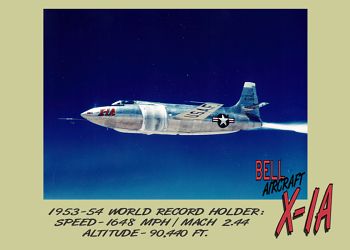Bell X-1A (48-1384)
The Bell X-1A (48-1384) was designed for aerodynamic stability and air-loads research. It was delivered to Edwards Air Force Base on 7 January 1953. The aircraft made its first glide flight on 14 February with Bell test pilot Jean "Skip" Ziegler at the controls. Ziegler also flew the first powered flight in the X-1A on 21 February. Contractor flights in the aircraft continued through April, at which time the X-1A was temporarily grounded for modifications.
Flight operations were resumed on 21 November 1953 with Major Charles "Chuck" Yeager as pilot. During a flight on 12 December, Yeager took the X-1A to a record-breaking speed of Mach 2.44 at an altitude of 75,000 feet. He then encountered the unpleasant phenomenon of inertia coupling. The X-1A tumbled out of control, knocking Yeager unconscious briefly before entering an inverted spin. Fortunately Yeager regained his senses and control of the aircraft 60 miles from Edwards at an altitude of 25,000 feet.
Next, the X-1A was used for a series of high altitude missions piloted by Major Arthur Murray. Fourteen flights proved necessary to meet the program requirements, with only four successful attempts. During the test series, Murray set several unofficial world altitude records. The highest, 90,440 feet, was set on 26 August 1954.
Following completion of the altitude program, the aircraft was turned over to the National Advisory Committee for Aeronautics (NACA). The X-1A underwent modifications and was returned to flight status in July 1955. The first NACA-sponsored flight, piloted by Joe Walker, took place on 20 July.

© Copyright 2004-, The X-Hunters. All rights reserved. Copyright Policy Privacy Policy Page last modified 05/01/2023


